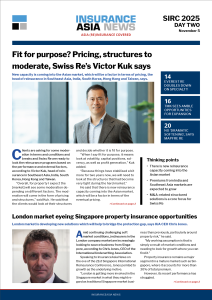SIRC: Distinct reinsurance solutions are emerging to address emerging capital strategies: Guy Carpenter
November 4 2025
Advancements in risk-based capital frameworks in the region is leading to increased levels of discussion around the sources and uses of capital, including reinsurance, from both tactical and strategic perspectives, according to Justin Ward, head of capital advisory for Asia Pacific at for Guy Carpenter.
As a “source of capital”, reinsurance’s strong loss absorption components serve a key role for insurers.
As insurers improve their understanding of the risks they are carrying and capital productivity.
“We are seeing discussions ranging from structured reinsurance, alternative sources of reinsurance capital right through to alternative value chain combinations”, Ward said.
“Across various jurisdictions, we have observed several distinct solutions emerging, including retrospective reinsurance, which acts like a ‘pseudo’ equity injection by releasing the capital associated with claims liabilities from the balance sheet.
“Growing interest and appetite in managing P&L volatility and valuation through solutions on the net retained position. This ultimately influences the ability of management to access other sources of capital on competitive terms.”
He also pointed to increased interest from private market investors seeking exposure to insurance risk, particularly risks with longer durations, which has resulted in a significant rise in sidecar-like facilities.
“At the same time, we continue to work with carriers to develop strategic reinsurance solutions that extend risk transfer and foster relationships enabling growth, capital and volatility management,” he added.
Prudential changes
With K-ICS in South Korea, RBC2 in Malaysia, new minimum capital requirements in Indonesia, and the Monetary Authority of Singapore’s consultation on the catastrophe risk charge under their risk-based capital framework, there are several regulatory reforms on the cards across Asia Pacific.
The risk-based capital framework in Hong Kong, which was adopted a year ago, has shown little demonstrable impact on consumer outcomes such as affordability and availability.
However, “has provided greater insight into balance sheet risks for many stakeholders, including regulators, rating agencies, and shareholders,” Ward noted.
“Insurers are becoming increasingly aware of the risks they are carrying, the interaction between these risks, including their interlinkages during periods of significant stress, and the controls used to manage them,” he added.
Meanwhile, insurers are increasingly building capabilities related to capital productivity by measuring capital consumption by risk and lines of business and explicitly allocating capital accordingly while considering the “Three R’s” – regulatory, ratings and risk-based capital.
“Finally, insurers are focusing on different sources of capital such as equity, debt or reinsurance capital, along with understanding the loss absorption characteristics of these sources,” according to Ward.
Keeping up
In the face of this rapid regulatory transition, best practice encompasses understanding the problem, identifying stakeholder requirements, learning from others facing similar problems, and drawing insights from other jurisdictions.
This is incredibly important in the Asian context, given the nature of change across multiple jurisdictions.
“We always advocate for compliance that achieves commercial outcome, not just meeting the minimum requirements,” he added.
“It is critical to meet these requirements while ensuring that insurers can drive commercial decision-making and outcomes from their compliance efforts.”
Bottomline
Expanding on how these regimes and regulatory reforms are impacting companies’ product strategies and expansion plans in the region, Ward said that, as with the introduction of any changes to prudential arrangements, signalling from the regulator to industry participants occurs.
“We don’t view it as a wholesale change related to product offerings or launches,” he said.
“What we see is a greater focus on ‘return’ metrics by product, and in some cases by product and channel, resulting in changes in product design, pricing and sometimes a reduction in appetite for certain lines of business.”
-
QBE’s Hammond on transformation and growth
- July 2
The Asia chief executive discusses Covid-19, going digital and restructuring.
-
Swiss Re: Nat cats and man-made disasters in 2018
- April 10
Climate change, increased urbanisation and a growing concentration of assets were on the risk agenda for 2018.
-
Willis Towers Watson: 2019 Asia Market Report
- March 19
Economic uncertainty, more complex risks and tighter underwriting are all influencing Asia's markets.
-
Peak Re: Emerging Asia’s life and health opportunity
- March 11
Life and health premium growth is expected to outpace GDP gains in eight Asian markets.
-
Beazley | What does cyber protection look like from day 1 to day 600 and beyond?
Cybersecurity is no longer just an IT concern, but a governance issue that belongs on the boardroom agenda.
-
Sedgwick | Preparing for the next storm
Insurance industry needs to recalibrate, invest in innovation and strengthen systems, talent and data practices.
-
Peak Re | From climate modelling to market opportunity: Forging a new clarity on Southeast Asia’s climate risk
Southeast Asia's protection gap: a crisis of clarity, not just capital
-
BHSI WICare+ | Accelerating Payments, Empowering Recovery
Launched in cooperation with Steadfast’s Singapore network, WICare+ fills the gaps found in traditional coverage and keeps businesses and their workforce secure by covering up to SG$350,000 in medical expenses per claim.

